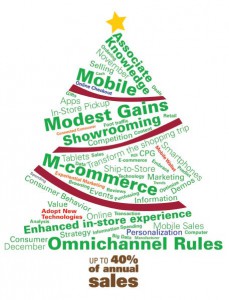 By Retail News Insider
By Retail News Insider
It’s a familiar feeling: that mix of excitement and anxiety that has you sitting on the edge of your chair come Christmas morning. We’re not just talking about the little ones waiting to open their gifts from Santa. That’s also the scene that plays out for most retailers each holiday season. From whether sales will be up or down over last year, to what factors will have the greatest influence on purchasing decisions, to which trends will signal the biggest changes for the coming year—there’s a lot at play this holiday season.
November and December are the biggest months of the year for most retailers—accounting for 20 to 40 percent of annual sales, according to the National Retail Federation (NRF). With over $600 billion on the line, retailers understandably want to know what they can expect. This year, firms ranging from financial services leader Morgan Stanley to software giant Adobe are harnessing the power of Big Data to deliver those predictions on demand.
As new players release their forecasts almost daily, it’s interesting to note how widely some of them vary. For example, technology services firm Accenture is predicting up to an 11 percent increase in total holiday spending, while Morgan Stanley predicts a the needle will barely budge over last year with a gain of just 1.6 percent. Is it a matter of different groups looking at different data? Variances in predictive models? Or something else? We can’t say for sure. But instead we can tell you what the majority of the industry does agree on.
#1: Sales will tick up, but it’s not a runaway
Though there are a few outliers, most industry leaders are predicting modest overall gains this holiday season. Consumer insights firm ShopperTrak predicts a 2.4 percent increase in same-store year-over-year sales, while the International Council of Shopping Centers and NRF predict overall holiday sales to increase by 3.4 to 3.9 percent, respectively.
These figures are actually slightly lower than the gains seen during last year’s holiday shopping season, despite the fact that the economy that has continued to improve. So what’s the reason for consumers’ caution? Many experts believe the recent government shutdown and ongoing budget woes are playing a big role. “Americans are questioning the stability of our economy, our government and their own finances,” said NRF President and CEO Matthew Shay in a recent press release. “We expect consumers to set a modest budget for gifts and other holiday related purchases as they wait and see what will become of the U.S. economy in the coming months.”
#2: Knowledge equals power—and register rings
There’s no denying that showrooming is still going strong, but according to financial advisory and consulting firm Deloitte, sales associate knowledge can make a big difference in where consumers choose to buy. Deloitte predicts that the majority of holiday spending will still take place at brick-and-mortar retailers this year, and more than half of shoppers will be more likely to buy at a store where sales associates are knowledgeable about the products they sell. In fact, Deloitte predicts product knowledge will be twice as influential as any other factor, including personalized coupons and mobile or self-checkout.
 #3: Mobile commerce will set the stage for its mainstream debut
#3: Mobile commerce will set the stage for its mainstream debut
Though mobile price-checking, product review and coupon apps have become a mainstay for both online and brick-and-mortar retailers in recent years, true mobile-enabled purchasing has received considerably less attention. Until now. According to Adobe, mobile-optimized industry leaders can expect mobile sales to soar 47 percent this year as compared to 2012. Overall, more than 20 percent of these retailers’ sales are predicted to come from smartphones and tablets.
According to Giovanni DeMeo, Interactions’ Vice President of Global Marketing and Analytics, this signals a greater trend for the coming year. “Historically, retailers have just taken their Web sites and made them optimized for mobile. Few apps actually enabled shoppers to buy. But shoppers want much more than coupons, store location information and recipes. Going forward, retailers will have to recreate the mobile experience for shoppers to ensure they’re enhancing the experience shoppers have with retailers whether in-store or out of store. Advanced options like m-commerce—using your mobile app to shop—are going to be the new standard in 2014 and beyond.”
#4: Offering a steal will help seal the deal
As we’ve seen for the past five years, most shoppers will still be driven by doorbusters, discounts and other promotions. This is one prediction that several groups can agree on in some form or another. According to Deloitte, 57 percent of shoppers will specifically target sales to help keep their spending in check. And 47 percent of shoppers will use discounts as their primary factor in choosing whether or not to buy a product, says Accenture. Overall, the NRF predicts discounts will have twice as big an impact on where consumers choose to shop as compared to any other factor, including selection and quality of merchandise.
#5: Omnichannel sales will be the real shining stars this holiday season
Despite the modest overall predictions for holiday spending, the NRF’s digital division Shop.org is predicting a significantly brighter outlook for omnichannel retailers who offer consumers multiple, integrated channels through which to shop. The group predicts the combination of online, ship-to-store and reserve for in-store pickup sales will rise 13 to 15 percent over last year, accounting for as much as $82 billion in sales. What’s more, with Deloitte predicting consumers who shop a combination of channels will spend up to 76 percent more than their in-store-only counterparts, finding and engaging those omnichannel shoppers stands to be a real advantage for individual retailers this holiday season.
Similar to the predicted increases in mobile commerce, this is one trend that shows no signs of stopping when the holiday decorations get packed away. “Retail is going through one of the biggest transformations we’ve ever seen in the industry,” says Abhi Beniwal, Interactions’ Senior Vice President of IT. “While our basic needs as consumers have not changed, the way we interact with technology has changed. That is what is driving the rise of trends like omnichannel retailing. As we move forward, retailers are going to have to adopt technology at a much faster pace than they have in the past. There will be mainstream adoption of advanced technologies like m-commerce and augmented reality. It’s all about consumers demanding a better shopping experience wherever they are (in-store, at home, on-the-go) and technology being the tool that can provide that.”
While the trends for holiday sales this year may be mixed on some levels, one thing is clear: technology is taking center stage—and will continue to do so for the foreseeable future. As a result, it will also be a big focus for us in the coming year. Here’s a sneak peek at the cutting-edge technologies, trends and key issues retailers will be facing—and we’ll be addressing—in 2014:


